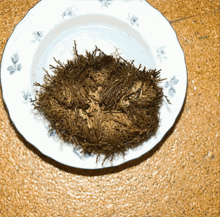| Revision as of 11:47, 25 May 2024 editPlantsurfer (talk | contribs)Extended confirmed users40,032 edits citationTag: 2017 wikitext editor← Previous edit | Revision as of 06:33, 29 July 2024 edit undo117.204.122.208 (talk)No edit summaryTags: Reverted Mobile edit Mobile web editNext edit → | ||
| Line 1: | Line 1: | ||
| A '''resurrection plant''' is any ] plant that can survive extreme dehydration, even over months or years. | A '''resurrection plant''' is any ] plant that can survive extreme dehydration, even over months or years. | ||
| They store pure concentrated sugar in their leaves and withdraws chlorophyll. This helps them to keep in dried condition. When wet it resurrects and takes about 48 hours to become green and restart it's photosynthesis. Meanwhile the sugar serves as food. (Adapted from Hope Jarhen in her memoirs 'Lab Girl'.) | |||
| ]'' reviving within 3 hours after the addition of water.]] | ]'' reviving within 3 hours after the addition of water.]] | ||
Revision as of 06:33, 29 July 2024
A resurrection plant is any poikilohydric plant that can survive extreme dehydration, even over months or years. They store pure concentrated sugar in their leaves and withdraws chlorophyll. This helps them to keep in dried condition. When wet it resurrects and takes about 48 hours to become green and restart it's photosynthesis. Meanwhile the sugar serves as food. (Adapted from Hope Jarhen in her memoirs 'Lab Girl'.)

Examples include:
- Anastatica hierochuntica, also known as the Rose of Jericho, a plant species native to deserts of North Africa
- Asteriscus (plant);
- Dorcoceras hygrometrica,
- Craterostigma, members of the Linderniaceae/Scrophulariaceae with snapdragon-like flowers
- Haberlea rhodopensis
- Lichen, a symbiosis that can survive extreme desiccation,
- Mesembryanthemum, the plant can revive within a short period of time after a drought
- Myrothamnus flabellifolius, a plant species native to Southern Africa
- Pleopeltis polypodioides, also known as resurrection fern
- Ramonda serbica, a species in the family Gesneriaceae
- Selaginella lepidophylla, a plant species native to North America, Central and South America, and sold as a novelty
- Tillandsia
- Xerophyta, a monocotyledonous genus of 57 species typically occurring on rock outcrops in Southern African grasslands
Certain resurrection plants have long been sold in their dry, "lifeless" form as curiosities. This custom was noted by many 19th-century authors, and continues today.
In December, 2015, resurrection plants were featured in a TED talk given by Professor Jill Farrant , Molecular and Cell Biology, University of Cape Town, South Africa, who performs targeted genetic modification of crop plants to make them tolerate desiccation by activating genes that are already there but not natively expressed in response to drought.
See also
References
- Liberty Hyde Bailey (1916). The Standard Cyclopedia of Horticulture. Vol. 5. The Macmillan company. pp. 2920–2921, 3639.
- Zhang, T.; Fang, Y.; Wang, X.; Deng, X.; Zhang, X.; Hu, S.; Yu, J. (2012). Badger, Jonathan H (ed.). "The Complete Chloroplast and Mitochondrial Genome Sequences of Boea hygrometrica: Insights into the Evolution of Plant Organellar Genomes". PLOS ONE. 7 (1): e30531. Bibcode:2012PLoSO...730531Z. doi:10.1371/journal.pone.0030531. PMC 3264610. PMID 22291979.
- "Resurrection Plant". Faculty.ucc.edu. Retrieved 2012-01-30.
- "Xerophyta Juss". Plants of the World Online. Royal Botanic Gardens, Kew. Retrieved 25 May 2024.
- "TED Speaker: Jill Farrant". TED.com. Retrieved 2016-01-21.
- "TED Talk: How we can make crops survive without water". TED.com. Retrieved 2016-01-21.
If an internal link led you here, you may wish to edit the linking article so that it links directly to the intended article.
This plant physiology article is a stub. You can help Misplaced Pages by expanding it. |